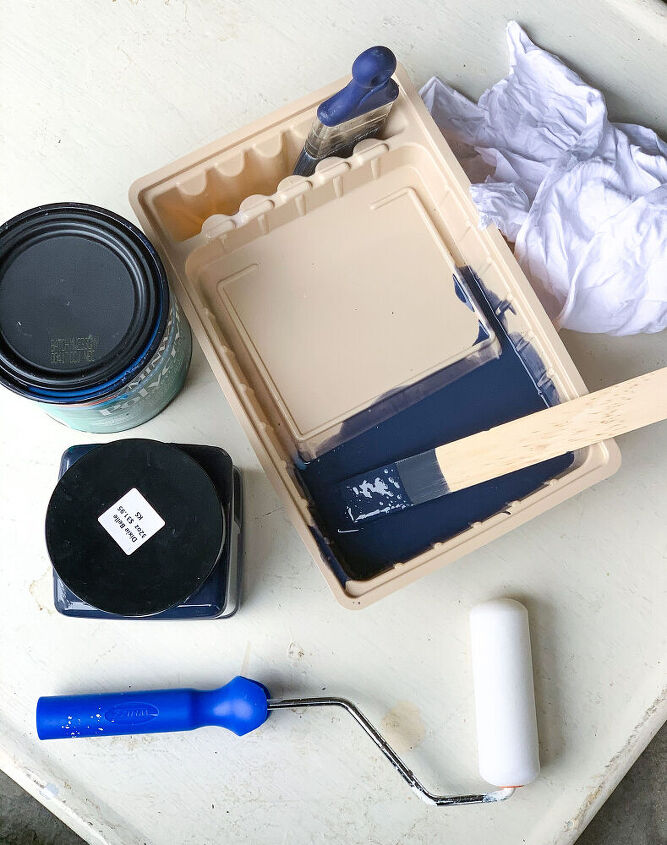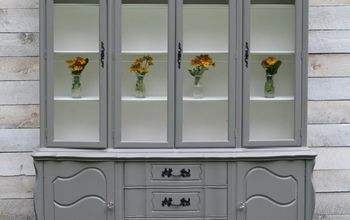First Time Using Chalk Paint // Dixie Belle Paint Co. + 5 Tips

This might be shocking but would you believe that I have ZERO experience with chalk paint. Crazy right?! I mean… How many pieces of furniture have I painted? When I first got started, chalk paint was a little out of my materials budget and when I could finally afford a better product I had already discovered milk paint. I completely skipped the chalk paint grade. The day has come for me to finally try it. 5 Tips at the end
Check out my 1st chalk paint experience on Youtube! Insta: @ amandasmercantile
My aunt gave me two squatty, shelving pieces to make into a matching set by color alone. She also handed over this Dixie Belle Mineral Chalk Paint in Navyto use on the project because the color perfectly matched something she already had.
Now, it is my understand that chalk paint requires no prep work and, in my opinion, has been touted as a novice-friendly product.
Despite that I decided to do just a little light sanding with 120 grit sandpaper on the inside & out before moving forward.
1st Coat |After cleaning the piece of any sanding dust, it was time for color. The first coat was a smooth application. The paint was a little thick but smooth.
I would start on one of the pieces and by the time I was done with the second, the paint on the first would be dry.
Dry time was about 45 mins to an hour but Chalk paint’s full curing time is around 30 days. I waited 24 hours in-between each step but it isn’t necessary to do.First coat coverage was great, that could just be because it was a darker color but so far so good.
2nd Coat |I didn’t do any sanding before the second coat. The application this time around wasn’t as smooth but I think that is because of the 1st coat’s chalky finish.
Protective Coat | This is where things went wrong. Now… I decided to used Minwax’s Polycrylic in Clear Matte just like I would on any other project but I was a little worried about the milky film that can form on darker painted piece from the poly.
I had heard of this tip… If you add some of the original paint to the top coat then it can help with the milky film problem.
Well… I did the mixing and the application but I still had some issues with it forming a milky film. I also had issues with the paint pulling up in some of the tighter areas of the piece when I was applying the poly. I don’t understand why that happened. For a product that is advertised as not needing any sanding before application, I feel as though paint pulling shouldn’t happen whether I had done any prep work or not. But I had done some light prep work in the beginning. Remember?
Final thoughts & What I Would Do Next Time | I give chalk paint in general a 6/10. In my opinion, I don’t think chalk paint is as easy to use as advertised and it definitely requires prep work to be done before use. I give Dixie Belle Mineral Chalk Paint (within the chalk paint category) a 7/10. It is a very thick product but has really good coverage after just one coat. It is a very pricey product though. 32oz for $40.... YIKES!
After doing some research I found out that the pros will actually add water to their chalk paint to make the application even smoother. I also found out that on darker colored pieces, like a navy or black, it is better to use a wax as the protective top coat to avoid the milky film problem & and having brush strokes that can be seen in the light. I wish I would have used my Miss Mustard Seed’s Beeswax for that final step.
I also think that chalk paint is best used for pieces that you plan on giving it distressed, rustic look. If you want a cleaner look I would suggest just using a cabinet & furniture paint. Valspar has a great product on the market for something like this and Lowe’s is pretty good at color matching too.
Tips for Working With Chalk Paint
- Do a light sanding and remove any waxy or oily finish before painting.
- Mist you chalk paint with a spray bottle of water to thin the paint before use. Just 3-5 spritzes and mixing should be enough and you can always add more.
- Lightly sand with 3M sanding block between coats of paint and before the protective coat.
- Only use a polycrylic protective coat on lighter colors of paint (ex: white, teal). Spritz and mix protective coat with water before application if using a polycrylic.
- Use a clear wax as protective coat on darker colored projects to avoid a milky film & and having brush strokes that can be seen in the light (ex: navy, black).
And that is my first experience with chalk paint! What are your thoughts? I feel like any issues I had could have been prevented if I had done more research and not assumed as much. Have you used chalk paint before or any Dixie Belle products and did you feel like there was a bit of learning curve to working with it? Please let me know!
Enjoyed the project?

Comments
Join the conversation
-
 Sally Bostwick
on Feb 28, 2022
Sally Bostwick
on Feb 28, 2022
My first experience with chalk paint was a real teaching lesson. Don't believe the no sanding, no primer if you are using a light color. My light color would have turned yellow had I not learned the tip you mentioned. Put a little of the paint color into the polyacrylic. It will keep it from turning yellow. Also, chalk paint is meant to be used with water, I believe to give it more of a "wash" look. My instructions said to dip my brush each time, then in the paint. Made for a very watery, drippy job. Used many coats over my forest green piece of furniture before I finally before had to face the fact I really did need to primer first.
-
-
 Sherry Mason
on Oct 08, 2022
Sherry Mason
on Oct 08, 2022
right. you do need to prime before using a color that is lighter than the original finish. My go to primer is Dixie Belle's Boss or Zinser's BIN. BIN has shellac in it to block the color and tannins in the wood from bleeding through.
-


















































Frequently asked questions
Have a question about this project?
If I paint my dining table what kind of protective finish can I put it at the end? Thanks
i think the project looks great, but given the extra cost of the chalk paint, what are the reasons to choose it? Why wouldn't a person use a regular good quality paint?